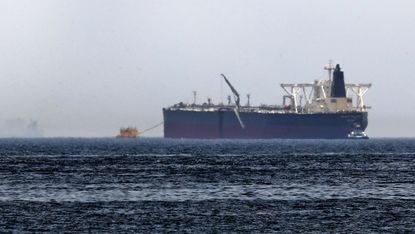Who is attacking Gulf oil tankers?
Tension at the world’s oil choke point could be the match that sets the Middle East alight

An international investigation into attacks on oil tankers off the coast of the United Arab Emirates last month has concluded that a “state actor” is the most likely culprit.
The UAE, Saudi Arabia and Norway told the United Nations Security Council there are “strong indications that the four attacks were part of a sophisticated and coordinated operation carried out with significant operational capacity”.
Of the commercial ships targeted in the blasts, on 12 May, “one was flying a UAE flag, two were tankers owned by Saudi Arabia, and the fourth was a Norwegian tanker”, reports CNN.
Subscribe to The Week
Escape your echo chamber. Get the facts behind the news, plus analysis from multiple perspectives.

Sign up for The Week's Free Newsletters
From our morning news briefing to a weekly Good News Newsletter, get the best of The Week delivered directly to your inbox.
From our morning news briefing to a weekly Good News Newsletter, get the best of The Week delivered directly to your inbox.
Both the US and Saudi Arabia have pointed the finger at Iran, but the investigation report does not identify any state as the alleged aggressor.
Tehran has denounced the attack and denied involvement. A senior Iranian lawmaker told Reuters that “saboteurs from a third country” could be behind the sabotage and that the incident showed the security of Gulf states was fragile.
According to the newly released investigation report, the attacks on the vessels, in UAE territorial waters 12 nautical miles off the emirate of Fujairah, required a “high degree of coordination” and advanced technical and intelligence capabilities.
Divers are believed to have attached limpet mines that blew up the tankers in an assault intended to “incapacitate the ships without sinking them or detonating their cargoes”, the report says.
There were no casualties, but Saudi Arabia says that two of its ships suffered "significant" damage.
As The Times notes, attacks on maritime traffic in the Gulf “have fuelled tensions already heightened by the unravelling Iran nuclear deal and Washington’s moves beefing up its military presence in the region, citing unspecified threats from Iran”.
US national security adviser John Bolton has warned of a “very strong response from the US” against the Islamic republic and its proxies in the event of further attacks in the Persian Gulf.
Although “it is unclear why Iran would carry out a relatively low-level attack on the multinational tankers”, observers have speculated that “it could have been to send a signal to forces ranged against it that it is capable of disrupting shipping there without triggering a war”, says the BBC.
Oil prices rose by nearly 2% immediately after the attack, amid fears that the vital choke point for the world’s oil supply could provide the match that sets the region alight.
In April, Iran’s Revolutionary Guard threatened to “close” the Strait of Hormuz, through which about a fifth of the world’s oil supply passes, if it was prevented from using the waterway. Days later, relations between the US and Iran hit a new low when Tehran passed a new law declaring any US troops stationed in the Middle East “terrorists”.
The US Maritime Administration then issued an advisory warning that “Iran or its proxies” could be targeting commercial vessels and oil production infrastructure in the region.
The US “has bolstered its military presence in the Gulf with additional troops, bombers and an aircraft carrier group”, reports the Financial Times. The heightened deployment is intended to deter further incidents, US officials have said.
Create an account with the same email registered to your subscription to unlock access.
Sign up for Today's Best Articles in your inbox
A free daily email with the biggest news stories of the day – and the best features from TheWeek.com
-
 Ottawa climate talks: can global plastic problem be solved?
Ottawa climate talks: can global plastic problem be solved?In the spotlight Nations aim to draft world's first treaty on plastic pollution, but resistance from oil- and gas-producing countries could limit scope
By Harriet Marsden, The Week UK Published
-
 Netherlands split on WFH for sex workers
Netherlands split on WFH for sex workersSpeed Read Councils concerned over 'nuisance' of at-home sex work, but others say changes will curb underground sex trade
By Arion McNicoll, The Week UK Published
-
 'He adored Trump, and then rejected him'
'He adored Trump, and then rejected him'Today's Newspapers A roundup of the headlines from the US front pages
By The Week Staff Published
-
 Sydney mall attacker may have targeted women
Sydney mall attacker may have targeted womenSpeed Read Police commissioner says gender of victims is 'area of interest' to investigators
By Julia O'Driscoll, The Week UK Published
-
 Why are kidnappings in Nigeria on the rise again?
Why are kidnappings in Nigeria on the rise again?Today's Big Question Hundreds of children and displaced people are missing as kidnap-for-ransom 'bandits' return
By Julia O'Driscoll, The Week UK Published
-
 The #MeToo movements around the world
The #MeToo movements around the worldThe Explainer French men have been sharing stories of abuse in the latest calling out of sexual assault and harassment
By The Week Staff Published
-
 Deaths of Jesse Baird and Luke Davies hang over Sydney's Mardi Gras
Deaths of Jesse Baird and Luke Davies hang over Sydney's Mardi GrasThe Explainer Police officer, the former partner of TV presenter victim, charged with two counts of murder after turning himself in
By Austin Chen, The Week UK Published
-
 How the idyllic Galapagos Islands became staging post in world drug trade
How the idyllic Galapagos Islands became staging post in world drug tradeUnder the radar Ecuador's crackdown on gang violence forces drug traffickers into Pacific routes to meet cocaine demand
By Harriet Marsden, The Week UK Published
-
 Armed gangs, prison breaks and on-air hostages: how Ecuador was plunged into crisis
Armed gangs, prison breaks and on-air hostages: how Ecuador was plunged into crisisThe Explainer Gangs launch deadly revenge after president declares state of emergency following escape of feared drug boss from prison
By Harriet Marsden, The Week UK Published
-
 Ecuador tips toward chaos amid prison breaks, armed TV takeover
Ecuador tips toward chaos amid prison breaks, armed TV takeoverSpeed Read New President Daniel Noboa authorized the military to 'neutralize' powerful drug-linked gangs after they unleashed violence and terror across Ecuador
By Peter Weber, The Week US Published
-
 Prague shooting: student kills 14 people at university
Prague shooting: student kills 14 people at universitySpeed reads Police believe suspect, who killed himself, may have shot his father before carrying out mass murder
By Arion McNicoll, The Week UK Published